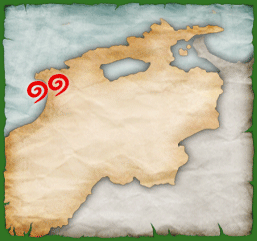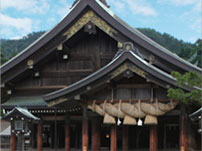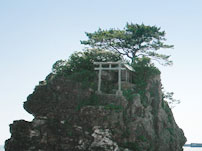Izumo Taisha
- Izumo Taisha
- Kami-ari-zuki, The Month of the Gods
- The Shrine in the Clouds
- Izumo Taisha Festivals
Izumo Taisha Festivals
Written by Dustin Kidd
While Kami-ari-sai is a very unique festival that can only be seen in Shimane, it is merely one of the many interesting festivals held year-round at Izumo Taisha. Many opportunities are available for visitors to Shimane to experience the distinctive festivals there, including:
- Kitcho-san (January 3rd) – In this festival, groups from 13 areas around Izumo Taisha welcome in the new year by praying for health and safety during the upcoming year. Each group forms a procession led by bannai, heralds that wear traditional kimonos and wear demon masks. Members play flutes or beat on taiko drums, and the group also has a Kitcho-ban, a colorful and magnificently decorated large flag. At certain points during the procession, each group sets up their flag and sings special prayer songs. New Year’s visitors enjoy seeing the various groups, and bannai costumes are available at Izumo Taisha for visitors to try on. Kitcho-san finishes before noon, so if you plan on attending, get there early.
- Fukujin-sai (New Year’s Eve/Day according to the lunar calendar) – Along with the current new year, the lunar calendar New Year (referred to in some countries as “Chinese New Year”) is also celebrated. It begins on the evening of New Year’s Eve, as participants start to fill Izumo Taisha’s Kagura-den. Everyone stays there until the festival itself begins at 1 AM, and drawings for tokens of good fortune are held once the ceremonies are finished. Everything usually wraps up around 4 AM. Along with Kami-ari-sai, the date for this festival changes every year, but it usually happens in early to mid-February.
- Rei Tai-sai (May 14th) – This is the liveliest, most important festival of the year. Priests perform archery to drive away evil spirits, ta-ue-mai (a dance that reenacts traditional rice planting) is performed, and priests also do yabusame (archery performed on horseback). An interesting facet of this festival is that official messengers from the Emperor bring offerings to the shrine. Among the myriad shrines throughout Japan, for this to happen annually is very rare, so this illustrates the strong connection between Izumo Taisha and the Imperial Household. The main part of the Rei Tai-sai is held on May 14th, but other related events continue for the two following days.
- Koden Shinjo-sai (November 23rd) – This is a special ceremony held to give thanks for each year’s harvest, and to pray for a bountiful harvest and the prosperity of the nation in the upcoming year. The head priest of Izumo Taisha shares a meal with the deity from which his family descends, and all of the food is prepared using fire-making tools specially made for this occasion. These tools are not created at Izumo Taisha; they are provided by Kumano Taisha, a shrine in Matsue City. Every October 15th during Kumano Taisha’s Sanka-sai, the head priest of Izumo Taisha, accompanied by several other priests from the shrine, travels to Kumano Taisha to receive these implements. In return, they bring two large, oblong rice cakes as an offering. These rice cakes are accepted by a low-level priest from Kumano Taisha in a ceremony known as Kamedayu Shinji. What makes this particular ceremony so unique is that the priest from Kumano Taisha doesn’t simply accept the rice cakes and hand over the tools for Izumo Taisha’s ceremony; from a position of superiority, he first examines them, and then proceeds to find fault with them. The priests from Izumo Taisha must listen in silence as the shape, size and color of the rice cakes are all criticized. However, before giving the fire-making tools to the priests from Izumo Taisha, the priest from Kumano Taisha makes them promise to bring rice cakes that meet Kumano Taisha’s specifications the next year. This is a confirmation of the continuing relationship between the two shrines. Finally, when the priest has had his say, he accepts the rice cakes. However, before giving the fire-making tools to the priests from Izumo Taisha, the priest from Kumano Taisha makes them promise to bring rice cakes that meet Kumano Taisha’s specifications the next year. This is a confirmation of the continuing relationship between the two shrines. All of this, from the fault-finding to the eventual acceptance and exchange of items, is predetermined.
While Izumo Taisha’s Koden Shino-sai is not open for viewing to the public, Kumano Taisha’s Sanka-sai, including the Kamedayu Shinji, is.
Places Connected with Izumo Taisha Festivals:
Kumano Taisha is located in the Yakumo area of southern Matsue City. It is a shrine with a long history, and is also known as the Ichi-no-miya (translates literally to “number one shrine”) of the Izumo region. Kumano Taisha, as the Ichi-no-miya of Izumo, was a very important shrine in the region, and the fact that priests from Izumo Taisha came here to receive the tools for the Koden Shinjo-sai Festival reflects the strong relationship between the two shrines.
- Dustin Kidd, Japanese Cultural Scholar
- Author of “Oi Genki Ka!?”, a collection of essays about life in Japan and “San-in English School”, a daily column about different facets of life in the San-in Region of Japan, which ran from Oct. 2009 to Mar 2011.
Lecturer: “Comparing Japanese and Greek Mythology”, “Experiences with Shinto”, “The Appeal of Shinto and Buddhism.”
Visiting Locations connected to Izumo Taisha
Izumo Taisha is located on the western end of the Shimane Peninsula, in the Taisha area of Izumo City. A large shrine gate, said to be the largest in Japan, towers over the main road to Izumo Taisha and welcomes visitors to the area. Izumo Taisha is easily accessible by car, bus, or train, and the area around the shrine bustles with tourists and visitors to the shrine, especially on the weekends.
If you follow the road that passes in front of the shrine grounds, you will soon arrive at Inasa-no-Hama beach. This beach is part of Sono-no-nagahama, a place that plays a large role in the Kunibiki legend, and is where Takemikazuchi presented Okuninushi with his demands to turn over Ashihara-no-nakatsukuni to Amaterasu, and where Takeminakata challenged him to a test of strength. It is also where, every year at the Kami-mukae-sai, all of the gods from around Japan are welcomed to Izumo Taisha, and the procession back to Izumo Taisha from the beach follows a path through town along the Kami Mukae Road.


Izumo Taisha
195 Kizukihigashi, Taisha-cho, Izumo City, Shimane

Inasa-no-Hama
Kizukikita, Taisha-cho, Izumo City, Shimane













